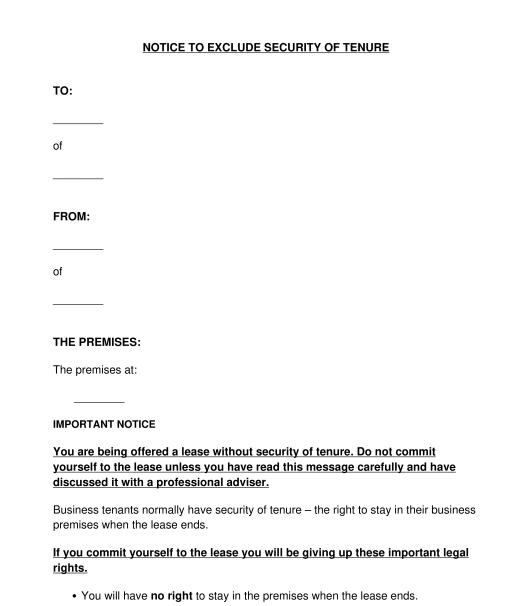 17/09/2025
17/09/2025

Answer a few questions and your document is created automatically.

Your document is ready! You will receive it in Word and PDF formats. You will be able to modify it.

 17/09/2025
17/09/2025
 Word and PDF
Word and PDF
 3 to 4 pages
3 to 4 pages
Security of tenure refers to the tenant's right to remain in the property and to renew the lease at the conclusion of the contractual term. Business leases generally have security of tenure, unless the parties explicitly agree otherwise. Short business leases with a fixed term of 6 months or less will not generally benefit from a security of tenure.
An agreement to exclude security of tenure in a business lease provides the required notices and declarations to allow landlords to exclude security of tenure in a business (commercial) lease in England and Wales.
Yes. If the parties want to exclude and op-out security of tenure that applies to business leases, they must enter into a written agreement about this.
Before a tenant signs an agreement to exclude security of tenure, it is best practice for the terms of the lease to be agreed. The agreement to exclude security of tenure must be entered into prior to the date upon which a party will be contractually bound to take the lease. This will be prior to:
The prospective tenant must be a prospective commercial/business tenant in England and Wales.
A prospective residential tenant cannot enter into this type of agreement.
Once the landlord has prepared the document, it should be sent to the prospective tenant. The tenant must then make a declaration in the required form, and return this to the landlord.
The formalities of the agreement will depend upon the amount of notice provided:
Once the tenant has made the relevant declaration the agreement should be returned to the landlord.
A statutory declaration involves an individual making a legal declaration confirming that something is true. In order to make a statutory declaration, the tenant must declare the relevant wording in front of a solicitor or person empowered to administer oaths. The tenant does not actually have to sign the agreement in this instance, but the solicitor/commissioner for oaths will sign the declaration.
If the tenant is making a statutory declaration they will need to pay for a solicitor or other person empowered to administer oaths to assist with this. The agreement must be given as a statutory declaration by the tenant if the notice to exclude security of tenure was provided by the landlord less than 14 days prior to the tenancy commencing or them being contractually bound to take the lease.
An agreement to exclude security of tenure should contain:
The following key legal provisions will apply to an agreement to exclude security of tenure:
You fill out a form. The document is created before your eyes as you respond to the questions.
At the end, you receive it in Word and PDF formats. You can modify it and reuse it.
Guides to help you
Country: United Kingdom